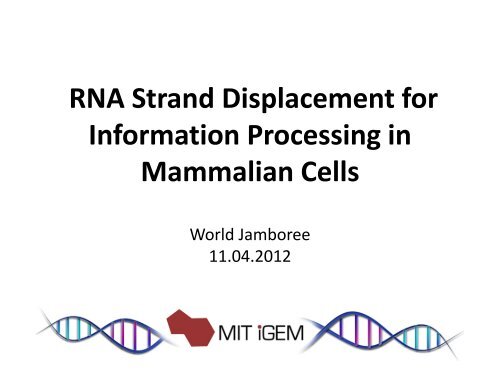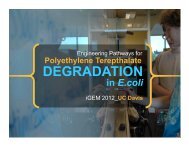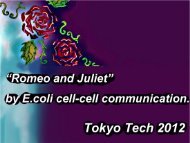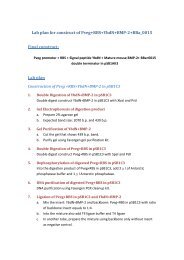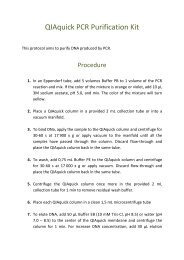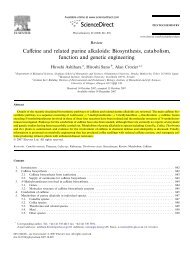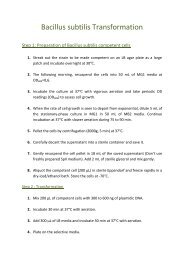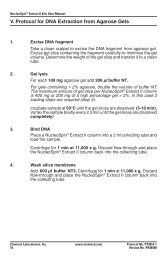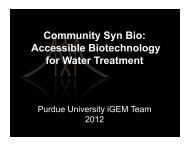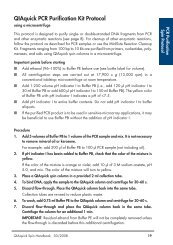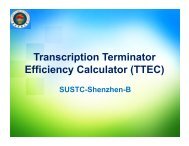MIT Championship Presentation - iGEM 2012
MIT Championship Presentation - iGEM 2012
MIT Championship Presentation - iGEM 2012
Create successful ePaper yourself
Turn your PDF publications into a flip-book with our unique Google optimized e-Paper software.
RNA Strand Displacement forInformation Processing inMammalian CellsWorld Jamboree11.04.<strong>2012</strong>1
Number of gatesThe Importance of Smaller PartsSynBio Challenge:Make more sophisticatedcircuits to control cell behavior~10X Smaller Parts:Circuits with10X smallerparts1 2 3 4 5 6 7 8 9 1011 12 13 14 15 16 17 18 19 2021 22 23 24 25 26 27 28 29 30Current Transcriptional Parts:Circuits withtypical sizedparts123DNA required to encode logic circuits• Greater sophistication per unit DNA • Better delivery with payload limits • Less energy costMotivation Mechanism Processing Production Interfacing Key Reaction Conclusion Human Practices2
Number of Promoters / dsGatesProgression of Circuit Sophistication Over TimeIn vitro = In solutionIn vivo = In cells403530AIM: Demonstrate strand displacement25Qian et al., Science 20112015Transcription-translational circuitsIn vitro strand displacement circuitscomputation in cells10502000 2002 2004 2006 2008 2010 <strong>2012</strong>YearMoon et al., Nature <strong>2012</strong>Adapted from Purnick et al., Nature MCB 2009Analysis of strand displacement publications from Pierce,Winfree, and Yurke groupsMotivation Mechanism Processing Production Interfacing Key Reaction Conclusion Human Practices3
Signals and ComputationBUFFER NOT OR ANDIn traditional transcriptional circuits:0 0Low activatorInput signal = 0Low proteinOutput signal = 0High activatorInput signal = 1High proteinOutput signal = 11 1BUFFERMotivation Mechanism Processing Production Interfacing Key Reaction Conclusion Human Practices
Signals and Computation: Strand DisplacementHigh signal (single-stranded DNA): 1Low signal (double-stranded DNA): 0(We use fluorescence as a proxy to indicate signal level)0 0Input signal = 0 Output signal = 0Low signalInput signal = 1 Output signal = 11 1High signalBUFFERMotivation Mechanism Processing Production Interfacing Key Reaction Conclusion Human Practices
Mechanism of Toehold-MediatedStrand DisplacementS1InputSignalS215 ntS2S3OutputSignalS2*GateBUFFERMotivation Mechanism Processing Production Interfacing Key Reaction Conclusion Human Practices6
Mechanism of Toehold-Mediated StrandDisplacementS1S2TS3OutputSignalInputSignalTS215 ntS2InputSignalS1TS2S3TS3OutputSignalOutputSignalBUFFERT* S2*T*Gate5 ntQian et al. 2011Motivation Mechanism Processing Production Interfacing Key Reaction Conclusion Human Practices7
Mechanism of Signal CascadingInputSignalS2TS3InputSignalS1TS2T* S2* T*GateBUFFER BUFFERQian et al. 2011Motivation Mechanism Processing Production Interfacing Key Reaction Conclusion Human Practices8
Mechanism of Signal CascadingS3S4InputSignalS2TS3TOutputSignalInputSignalS2TS3TS4OutputSignal* T*teT* S3*T*GateBUFFER BUFFERQian et al. 2011Motivation Mechanism Processing Production Interfacing Key Reaction Conclusion Human Practices9
Overview of In Vivo Strand DisplacementSystemsSensingInputsProcessingInformationActuatingResponsesProducingCircuits10
Processing InformationQian et al. 2011Nothing compatible?ANDORNOTTrue if both inputs trueTrue if at least one input is trueInverts a signalMotivation Mechanism Processing Production Interfacing Key Reaction Conclusion Human Practices11
Our NOT Gate Using Strand DisplacementInput StrandDynamic Gate(A)Output (B)Buffer (C)Fuel / Catalyst (D)Operation: Low InputHigh OutputDynamic Gate(A)0 1NOTOutput (B) Output (B)B is free to act downstream!C is displaced.Motivation Mechanism Processing Production Interfacing Key Reaction Conclusion Human Practices12
Our NOT Gate Using Strand DisplacementInput StrandDynamic Gate(A)Output (B)Buffer (C)Fuel / Catalyst (D)Operation: High InputLow OutputInput StrandDynamic Gate(A)Output (B)1 0NOTB is trapped, cannot act downstream!C is ‘stable’.Motivation Mechanism Processing Production Interfacing Key Reaction Conclusion Human Practices13
OutputOutputOur NOT Gate In VitroDesignSimulateTestVisual DSDUsing ODEs9 reactions per NOT gatePlate reader studiesMeasuring fluorescence100 uL reactionsCooperative Initial Hybridization Simulation at LowConcentrationsNOT Initial Gate Transfer FunctionInputInputSimulations using Visual DSD; experiment by Jon, GiulioMotivation Mechanism Processing Production Interfacing Key Reaction Conclusion Human Practices14
Producing CircuitsSensingInputsProcessingInformationActuatingResponsesProducingCircuits15
In Vivo Implementation ChoicesTST l * S l *In vitroIn vivoUtilize RNAMammalian Cells1 cell cycle24 hours• Can be produced continuously• Provide for dynamic circuit operation• Slow dilution rate• Natural RNAi pathway• RNA more stableMotivation Mechanism Processing Production Interfacing Key Reaction Conclusion Human Practices16
Transcription of Short RNAs In Vivo67nt shRNAMammalianHEK293 cellU6 TetO shRNA FF1 Hef1A eYFP-4xFF1Hef1A TagBFPTransfection markerKnockdown of Hef1A:eYFP-4xFF1 using U6-TetO:FF1U6 TetO Sequence: Henriksen et al., NAR 2007 Built by Lealia, Transfection by Linh, FACS by NathanMotivation Mechanism Processing Production Interfacing Key Reaction Conclusion Human Practices17
Interfacing With the CellSensingInputsProcessingInformationActuatingResponsesProducingCircuits18
Sensing mRNA InputsSensorInput mRNA+OutputGateDesign rules• orthogonality• three-letter code• accessibilityFuelGate+Short RNAOutputSignalDownstreamInputSignalMotivation Mechanism Processing Production Interfacing Key Reaction Conclusion Human Practices19
Sensing mRNA for Cellular InterfacingNUPACK Rendering of eBFP2 mRNAMotivation Mechanism Processing Production Interfacing Key Reaction Conclusion Human Practices20
Sensing mRNA In Vitro Using DNA-Based Sensor2.03 2.62 2.28 3.18BaselinemRNA Input+ +Presence of mRNA yields fluorescence1 2 34IVT by Lealia, Data by Eerik and ChelseaMotivation Mechanism Processing Production Interfacing Key Reaction Conclusion Human Practices21
Using Strand Displacement: FeasibleSensingInputsProcessingInformationActuatingResponsesProducingCircuits22
The Key Reaction Behind It All1 1REPORTER BUFFERInput StrandOutput StrandGateHigh green / Low redMotivation Mechanism Processing Production InterfacingKey Reaction Conclusion Human Practices23
The Key Reaction Behind It All1 1REPORTERInput StrandOutput StrandOutput Input StrandGateHigh green / High redMotivation Mechanism Processing Production InterfacingKey Reaction Conclusion Human Practices24
The Key Reaction: In Vitro with RNAT S1 S6Incorrect InputInput StrandStrandS6+ +TS6T* S6*T* S6*Reporter Fluorescent ComplexS6Waste1 1REPORTERData collected by Eerik/Chelsea/Felix 25Motivation Mechanism Processing Production InterfacingKey Reaction Conclusion Human Practices
In Vivo RNA DeliveryT = 0h T = 2h T = 3h T = 4hVesicleHEK293cellTaggedRNAVideo HereExperiment by Katie
The Key Reaction with RNA in Cells: Iteration 1TSInput StrandS+ +T * S*T* S*Reporter Fluorescent ComplexTSSWaste1 1REPORTERTransfection by Katie, FACS by NathanMotivation Mechanism Processing Production InterfacingKey Reaction Conclusion Human Practices27
DesignTestMotivation Mechanism Processing Production InterfacingKey Reaction Conclusion Human Practices28
The Key Reaction with RNA in Cells: Iteration 2T longS longInput StrandS longT longS long+ +T long * S long *T long * S long *Reporter Fluorescent ComplexS longWasteWe got RNA Strand Displacementto work in mammalian cells!~6 fold increase in redNucleofection by Giulio, FACS by Rob• Longer toehold, hybridization domain• Orthogonal sequencesMotivation Mechanism Processing Production InterfacingKey Reaction Conclusion Human Practices29
Experimental AccomplishmentsPROCESSINGCIRCUIT PRODUCTIONCELL INTERFACINGTOEHOLD-MEDIATEDRNA STRAND DISPLACEMENTAND OR NOTInput StrandNOT Gate Transfer FunctionOutput StrandGateKEY REACTIONMotivation Mechanism Processing Production Interfacing Key Reaction Conclusion Human Practices30
An Example Future Cancer Detect-and-Destroy CircuitEnabled by Our ResultsSensingANXA2G 1:1,8 S8m1 TT*ProcessingActuationCD-55CEACAM-6SEL1LBRCA2INK4AG 2:2,8G 3:3,8T1* m1*S8m2 TT2* m2* T*S8m3 TT3* m3* T*Th 4:8,7T4*Th 5:8,7T5*Th 6:8,7T6*m4 S8* T* s7*m4*m5 S8* T* s7*m5*m6*S8S8m6 S8* T* s7*S8G 8:8,9 S9S8 TT*T*S7TG 9:9,10S8*T* S9* T*w 9,f SfS9 Tw 7,8Motivation Mechanism Processing Production Interfacing Key Reaction Conclusion Human PracticesS8Th 8,9:9s8* T*S9S9*S9S10TANXA2CD-55CEACAM-6SEL1LBRCA2INK4APancreatic Cancer (PDAC)Killerproteinproduction31
New MammoBlocks (RFC 65) / BioBricks37BiobricksBest 22 Parts Submitted To Registry40MammoBlocks37 Logic Parts for StrandDisplacementBBa_K779500 BBa_K779501 BBa_K779502BBa_K779503 BBa_K779504 BBa_K779100BBa_K779101 BBa_K779102 BBa_K779103BBa_K779104 BBa_K779105 BBa_K779106BBa_K779107 BBa_K779108 BBa_K779109BBa_K779110 BBa_K779111 BBa_K779112BBa_K779113 BBa_K779114 BBa_K779115BBa_K779116 BBa_K779117 BBa_K779118BBa_K779119 BBa_K779120 BBa_K779121BBa_K779122 BBa_K779123 BBa_K779124BBa_K779125 BBa_K779126 BBa_K779127BBa_K779128 BBa_K779129 BBa_K779130BBa_K77913110 RegulatoryComposite PartsBBa_K779400 BBa_K779405BBa_K779401 BBa_K779406BBa_K779402 BBa_K779407BBa_K779403 BBa_K779408BBa_K779404 BBa_K7794092 TranscriptionalRegulatorsBBa_K779305BBa_K77930810 GeneratorsBBa_K779600 BBa_K779601BBa_K779602 BBa_K779603BBa_K779604 BBa_K779605BBa_K779606 BBa_K779607BBa_K779608 BBa_K7796093 PromotersBBa_K779200BBa_K779201BBa_K7792024 Hammerhead RibozymeCoding SequencesBBa_K779315BBa_K779316BBa_K779317Bba_K77931813 ReportersBBa_K779300 BBa_K779307BBa_K779301 BBa_K779309BBa_K779302 BBa_K779310BBa_K779303 BBa_K779311BBa_K779304 BBa_K779312BBa_K779306 BBa-K779313BBa_K779314
Outreach: Middle School, High School, CollegeSummer HSSP: Educating local middle school students• Biology Lecture Series: Synthetic Biology• Focus on applications, practices, and opportunities in synthetic biologySplash: Educating local high school students• <strong>MIT</strong> Educational Studies Program• Coming soon! November 17, <strong>2012</strong><strong>MIT</strong>: January Term Synthetic Biology Class• “Engineer Your Own Bacteria” 2 week lecture, wet labWellesley: Building multi-university communities• Use case for Wellesley HCI software• Bridging gap between tool designer and end-userMotivation Mechanism Processing Production Interfacing Key Reaction Conclusion Human Practices33
Acknowledgments<strong>MIT</strong> <strong>iGEM</strong> <strong>2012</strong> TeamFelix Sun, Giulio Alighieri, Eta Atolia, Katie Bodner, Jonathan Elzur, Keren Greenbaum, Divya Israni, LealiaXiong, Chelsea Voss, Kristjan Eerik Kaseniit, Nathan Kipniss, Jenna Klein, Robert Learsch, Wilson Louie,Ala’a Siam, Linh VuongCoordinators:Ron Weiss (faculty)Jonathan BabbDeepak MishraLab Shift Monitors:Jameel ZayedKenneth H. HuLeanna S. MorishiniMariya BarchMark Andrew KeiblerNathan S. LachenmyerSebastien LemireAdditional thanks to:Lulu QianChristopher VoigtPeter Andrew Carr Feng ZhangNevin M. Summers Jacquin NilesTimothy Lu Kristala L. JonesDomitilla Del PratherVecchioRahul SarpeshkarAlice M. Rushforth Narendra MaheshriRoger Kamm Natalie KuldellBU-Wellesley <strong>iGEM</strong> TeamThanks to our sponsors for their generous support!
NOT Gate Transfer FunctionPROCESSINGCIRCUIT PRODUCTIONCELL INTERFACINGThank you!Questions?KEY REACTION
Highly Scalable Parts ComparisonTranscriptional:Strand Displacement:Hef1A1174 bpCag1718 bpU6187 bpHef1A: TAL EffectorTAL-VP16 w/ 17bp DNA recognition1174 + 2477 = 3651bpHH– Gate:Output – HH216 bpPoly A / Terminator527 bpU6 terminator6 bp3651+527 = 4178bp 187+216+6 = 409bp
Strand Displacement ReactionsQian et al. 201138
AND, OR Logic Using Strand DisplacementQian et al. 201139
Full NOT Gate Reaction DiagramCase: No input present high output signalDynamic Gate (A)ReversibleNo InputStrandDownstreamInput (B)Downstream Input (B) reacts:DownstreamInput (B)Buffer (C)Fuel / Catalyst (D)Signal!Case: Input present low output signalTrapped!Input StrandDynamic Gate (A)IrreversibleB40
Digital NOT Gate Behavior
RFC65 Review: Recombination CloningKanpENTROri Kan OripENTRL4PromR1L1GeneL2R4CmccdBR2TermpDESTAmpMarkerLRB4PromB1GeneB2TermpEXPRAmpMarker42
Actuation: Controlling Hammerhead Activity+cleavescleavesc.f.cleavesHammerhead-Stem(inactive)Input StrandActive HammerheadDesign by Divya & Eerik, Hammerhead adapted from Yen et al. 200443
Transduction of Nucleic Acids to Protein OutputsInput Output ProteinNoneGFPmRNA is stable,protein producedGFPcleavesmRNA unstable,no protein expression
Actuation: Testing Hammerhead CleavageHef1A mKate Hef1A Hammerhead mKate Hef1A mKate Hammerhead45
Producing Components Using Transcription andHammerheadsHammerheadInitial RNA TranscriptOutputS2TS3T*S2* T*GateHammerheadRNA FoldsHammerheadCleavesGoal:46
In Vitro Strand Displacement: Iteration 2T longS longInput StrandS long/bulgeT longS long+ +T long * S long *T long * S long *Reporter Fluorescent ComplexS long/bulgeWaste47
In Vivo Strand Displacement: Iteration 2T longS longInput Strand+S longT long * S long *ReporterT long S longT long * S long *Fluorescent Complex+S longWaste48
The Key Reaction: In Vivo Iteration 2 (Bulge)T longS longInput StrandS longT longS long+ +T long * S long *T long * S long *Reporter Fluorescent ComplexS longWaste• Longer toehold• Longer hybridization domain• Incorporation of bulge region• Orthogonal sequencesNucleofection by Giulio, FACS by Rob1REPORTER49
Optimizing Transfection of 2’-O-Me dsRNA50
Inducible Expression Systems
Cellular-RNA-Compatible Actuation: Relieving miRNARepression with DecoysAntisense to miRNAmiRNAHef1AmKate-IntronicmiR-FF4Hef1A-LacOeYFP-4xFF4U6-TetODecoy FF4TuD FF41:0:1 Reporter:miRNA:Decoy1:1:1 Reporter:miRNA:Decoy1:1:2 Reporter:miRNA:DecoySlight Relief of miRNA Knock-Down of Reporter via Antisense Decoy RNA
Outreach: InternationalInternationalization Project of Synthetic Biology• Launching a collaboration between <strong>MIT</strong> and Tel-AvivUniversity.• Bringing together high school Palestinians and Israelisfor three years to work on an <strong>iGEM</strong> technical andentrepreneurial projects.• One-year pilot program to be launched this summer.• A college component and an incubator to follow.Synthetic Biology Policy Research• One student conducted synthetic biology policy research, withProf. Kenneth Oye of <strong>MIT</strong>’s Engineering Systems Division.• Work presented in SynBERC retreat and at a conference in theWoodrow Wilson International Center for Scholars.Motivation Mechanism Processing Production Interfacing Key Reaction Conclusion Human Practices53


